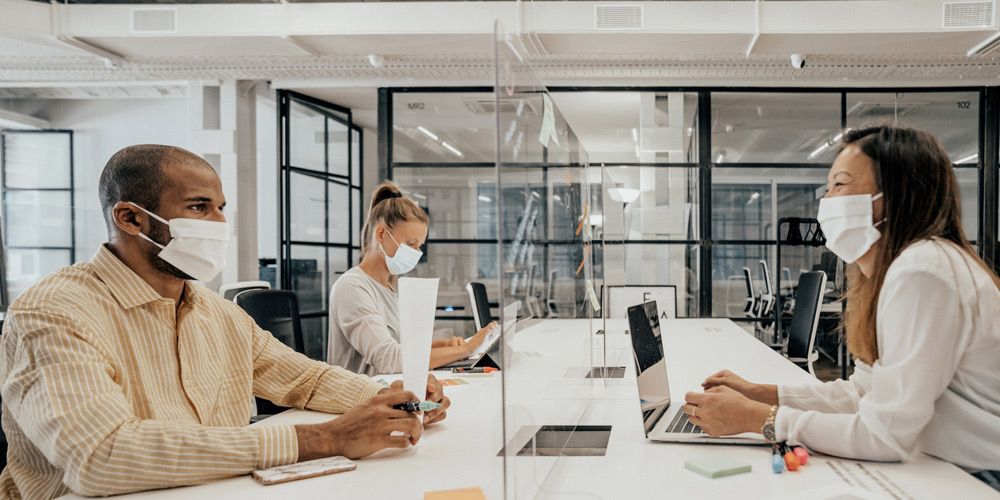Getting back to the future...of work
As businesses cope with COVID-19 disruptions, they need to rethink and reconfigure their workforce and work spaces beyond redesigning physical spaces.
Business leaders who are fond of saying their most valuable assets walk in the door each morning will have to come up with a new aphorism. As more firms realize the virtues of virtual work, many business leaders are taking the opportunity to rethink their organizations from the ground up, which will change who walks through which doors, when, and how often, and even where those doors might be. In light of the disruption caused by COVID-19, workforce concerns and strategies have elbowed their way to the top of C-suite executives’ priorities, no matter the sector.
When the lockdowns hit, the scramble to ensure business continuity was top priority. We witnessed a massive global experiment in whether we could work remotely and balance the demands of work, caring, kids, and pets with our video cameras on and our laptops perched on the best available surface. Throughout the height of the crisis, PwC surveyed CFOs regularly to learn about how their companies were responding to changing conditions and planning for the longer term. In April, nearly half (45 percent) of businesses were worried about losing productivity due to remote work. By June, only 26 percent were concerned about productivity drop-offs.
Many companies, particularly in the knowledge sector, are coping with COVID-19 workforce disruption in the short term by exhibiting agility — both financial, to shore up balance sheets, and physical, to switch to remote working. But the actions they take in the coming months as the recession deepens will be key. Leaders will need to adopt new ways of working to ensure the health, well-being, and productivity of their workforce and reengineer operations for a sustainable future.
And all of this is happening at a time of heightened concern for social justice, diversity, and inclusion as the Black Lives Matter movement reverberates around the world. Firms’ workforce policies and practices are already under scrutiny that can be intensified in a blink by social media. Those watching are not simply shareholders; the new corporate stakeholder includes consumers, influencers, policymakers, and more. In Australia, as the pandemic set in, Qantas Airways came under such public attack for laying off 20,000 staffers that it looked for ways to redeploy some of them temporarily to supermarket chains, which were swamped with increased demand as the country prepared to institute a stay-at-home policy.
Businesses that take advantage of the hiatus to repair, rethink, and reconfigure their workforces and work spaces will have a clear advantage over their competitors. This will require planning, a focus on people’s safety and well-being, an understanding of potential liabilities, the ability to manage productivity, and the use of productivity tools. In this climate, businesses will also need to develop new ways to measure and report impact and success amid increased transparency and scrutiny.
The here and now
The health and safety of employees — be they essential workers, those transitioning back to the physical workplace, or remote workers — is the first obligation. Protecting workers’ rights is also top of mind for many employers, unions, and activists. Retrofitting workplaces to protect people from the coronavirus can be expensive, and in some places doing so is a regulatory requirement as well as a major liability issue. Employees who are unclear about whether it is safe to go back to work pose a potential litigation threat, because companies in most countries are, by law, supposed to protect their people. But some states in the U.S., for example, do not provide unemployment benefits to workers who refuse to return to work, even if the reason for refusing is fear of an unsafe workplace.
An understanding of your organization’s place in an environment of rapidly changing societal and stakeholder needs provides you with the opportunity to rethink what your firm stands for.
One of the few pleasant surprises during this period has been the encouraging fact that productivity has held up and firms are assessing the benefits of remote working. Leaders who have previously demanded an office presence are deciding to maintain at least some virtual work or flextime, and, as a consequence, they are looking to consolidate their company’s physical footprint. More than half expect remote working to be a permanent part of their workforce strategy, according to PwC’s June survey of CFOs.
But with many people working remotely, health and well-being initiatives will be all the more important. When there are no set office hours, burnout is an issue (as much as simply slacking off), as is preserving connections among teams. The maintenance of worker productivity may have resulted from a high-adrenaline crisis response. We have seen a trend, in some companies, of superachievers assuming burdens they will find hard to sustain over the longer haul, which will skew future productivity measures.
Now is the time to invest some of what is saved on items such as the travel budget to create a better work experience for all. These efforts could include building ergonomic workstations or introducing reimbursements for childcare. And consider how to boost benefits that are going to make people’s working lives easier, safer, and healthier. For instance, one midsize U.S. financial-services firm allowed its now fully at-home workforce 10 extra vacation days through the end of 2020 to compensate for the extra stress of working from home, due to caring for children or older family members, dicey broadband connections, and noisy neighbors.
Some businesses have shown an impressive ability to pivot quickly, which is a skill to retain. Restaurants commenced delivery and curbside pickup; craft breweries switched to making alcohol-based disinfectants, and after some negotiation, General Motors turned a plant over to making critical-care ventilators, in partnership with Ventec Life Systems. Leaders need to keep such a capacity for agility in their back pockets.
The analytical edge
During what will be an enduring economic crisis, businesses will need data to drive the continued reshaping of activities in every category, from workforce strategy to leadership, performance, productivity, and organizational design. And firms that continue to invest in human resources, technology, and data will break away from the pack. We at PwC see in all of our CFO surveys and our experiences with clients that there’s never been a greater need to be able to draw insights from a strong set of workforce data, whether it’s where your people are located, what skills they have, which constraints are hampering either their work (either remote or in person), and how they are performing in this novel situation.
But as businesses review their tools, they need to ask whether the metrics for gauging workers’ health and productivity should be broader and more transparent. Stakeholders —including investors, employees, community, and customers — will assess businesses on a range of activities that include skills development, employability of staff, sustainable productivity, diversity and inclusion, safety and well-being, resilience, and work–life balance.
Digital management skills
Many managers do not have a playbook for leading remote teams — at least, not yet. Upskilling includes helping them lead in this new situation. For example, they should establish a level of informal connectivity, which remote workers want, by using frequent check-ins. The chief compliance officer of one company has instituted optional daily calls at 2 o’clock with his team that have garnered 100 percent attendance since they began in March.
With so many changes to the workforce and supply chains, now may be the time to invest in automation, whether on the factory floor or in the back office. Expand and accelerate training programs to elevate or augment your workers’ digital skills; robotic automated processes and AI applications require human skills to be effective. This type of employee upskilling and investment will make your firm more resilient and more competitive.
One recent PwC survey showed that three-quarters of workers understand the need to upskill to remain employable and are ready to learn new skills or retrain. Communities will also benefit if workers are upskilled. As for hiring new talent, think about redefining recruitment. Having people work remotely broadens recruiting horizons. The crises we’ve been living through — in public health and in gender, pay, and race equality — have seen leaders and talent emerge from far and wide.
Longer term
If you get the medium term right — the creative planning, well-being initiatives, technology investments, and appropriate budgeting — the long term will not only be easier but brighter because you will have built in the things you need: flexibility, supply-chain resiliency, and a blueprint for continuing automation and workforce training.
Now is also a time for scenario planning that considers the forces acting in the world today: More resilient supply chains are probably a must, whether they are local, regional, or global. Assess what skills your people need, and budget for training based on different business models. You may find that a greater proportion of contingent talent is appropriate if you need more variable costs, and a smaller proportion if fixed costs better serve your goals. The gig economy exploded at a time when the economy itself was on a long upward curve. In uncertain times, people often want the protection of a big firm. One of the large U.S. banks believes employee retention will improve, because job stability has suddenly become attractive.
And if the pandemic caused you to rethink your core business model — because certain countries or sectors are reskilling around particular trades — or opt for in-country design and manufacturing, leadership, or technical skills, you may see that certain of your strengths can be amplified in the new normal. Post-crisis realities may demand that different products be offered to different demographic groups or through different distribution channels.
None of this is fully new. But an understanding of your organization’s place in an environment of rapidly changing societal and stakeholder needs provides you with the opportunity to rethink and reconfigure what your firm and your constituencies stand for. For visionary leaders, now, as ongoing operations stabilize, is the moment to act.
Author profile:
- Bhushan Sethi is the joint global leader of PwC’s people and organization practice. Based in New York, he is a principal with PwC US.





